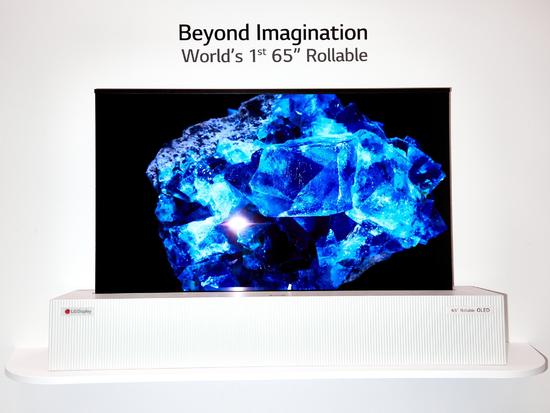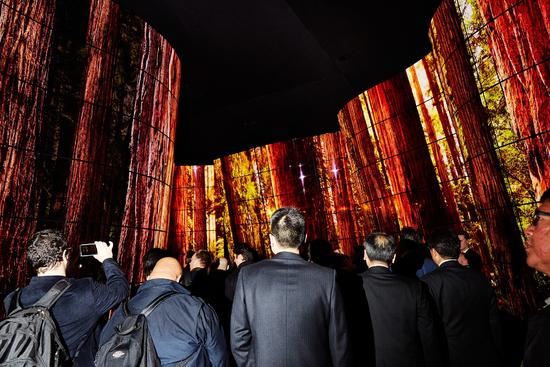
This article is the NetEase smart studio (public number smartman163) produced. Focus on AI and read the next big era!
[NetEase smart news January 13 news] CES is still a video conference. Although the tech industry is experimenting with augmented reality, self-driving cars, and external restrictions that can be embedded in refrigerators, everything in Las Vegas still revolves around the big screen. Most of the products of 2018 follow the path that manufacturers have followed for decades: everything has become bigger and clearer, and there are new, incomprehensible acronyms everywhere. Everything hopes you will have a new beginning in the new year.
Regardless of whether you are interested in upgrading your "box," this year's TV may be more able than any other CES to let you know the status quo of the entire technology world. Because TVs are no longer TV: They are smart home centers, virtual assistants, access points, game consoles, and powerful computers. And when the TV imitates the characteristics of other electronic devices, the mobile phone and the computer will also bring you benefits. Now every device you have contains enough connections and features to work, play, and play, and the difference between them becomes meaningless. Today, all kinds of devices are just screens, TV sets of various shapes and sizes.
Nothing can be an example of the massive expansion of the television industry like LG's latest prototype. The 65-inch display hangs on your wall and, like an ordinary television, is flat and strong. Just press a button, the display will extend down to its stand, wrapped in a coil like a wrapping paper. The screen can be completely rolled up for safe storage and easy movement, or you can leave a small portion and the screen will automatically become a "small piece" providing information to show weather and sports scores. Compared to most TVs, LG's devices have little in common except for its size. Functionally, it is more like a very large tablet. So what is this?
At the entire Consumer Electronics Show, companies are showing off their television sets. Samsung now treats its TV like any other smart home product: You can use the SmartThings app to control your TV next to the light bulb and thermometer.
Several manufacturers are releasing Android TV devices, which means they will work with Google Assistants to control smart home devices, and they can also play some Minecraft. Sony and other companies are developing short-throw projectors that can replace televisions and can replace TVs with a touch-friendly, infinitely adjustable surface.
Samsung, LG, and other companies are turning their televisions into digital art displays. When you don't, the screen switches from sunny to starry sky. If you purchase TCL's new soundbar, you can use the upcoming Roku entertainment assistant to continue playing music or get information without turning on the TV. Manufacturers have found that even though people now consume content differently, televisions still occupy the center of the house. It's big, plugged in, and everyone knows how to use it - in your smart home center you can't ask for more.
When television manufacturers tried to broaden the function of television, other electronics companies also began to try large screens. At GE's booth, there is a series of hoods, just like all fashionable HGTV homes. In addition to this, it has a 27-inch touch screen and two cameras. Both LG and Samsung will sell you a new refrigerator that is dominated by an equally large panel, which is good for viewing calendars and listing shopping lists. Technically speaking, Nvidia's "game panel" is a monitor with an ultra-fast refresh rate that can be used for more fluid games, but it looks like a TV on the table. Lenovo, JBL, and other companies are presenting "smart displays" to show information and videos through Google Assistant. Razer demonstrated a concept called Project Linda, which installed the Razer mobile phone into a brainless laptop case and used the phone as a computer and touchpad. Dell's new XPS 15 notebook supports HDR playback; OLED screens are blacker and more energy efficient, and can be displayed on devices of all sizes. None of them are easy to describe.

Today, smartphone processors from companies such as Qualcomm and Intel are strong enough to work reliably on any type of device, so companies have little reason not to use them. As a result, the boundaries between electronic devices are continuously shrinking. When Qualcomm and Microsoft work together to develop an always-on PC, they will use LTE network connectivity and Snapdragon processors. Are they developing large-scale handsets or laptops? The real answer is: This is not important.
This trend will only continue because the ultra-fast 5G network connection allows the device to move the required computing tasks to the cloud. Then anything that comes with a 5G chip and screen can be a game PC or video editing suite because all the heavy work is done elsewhere. This has happened: HP's Omen game streaming technology allows gamers to transfer high-definition video from an Omen's machine, and almost all computers can access the Internet. When the streaming media source becomes an Amazon server instead of a game PC, and it only takes a millisecond delay, you can play as strong as a watch pioneer on the phone.
In fact, you may not want to play a few hours of twitchy shooting games on your mobile phone. This is the key: You don't need to do this.
Many tech companies are beginning to think that in the next few years or decades, you will be able to use a lot of screens of different sizes. A small wrist, for notifications and displayable information. There is a bit bigger in your pocket for communication, Instagram and everyday life. A big point in the office may be connected to the keyboard. Maybe there is a big one in your living room that can hang in the evening. The screen in your car, the screen on your glasses, and the screen everywhere. This may not sound like much of the way it works today, but it will be -- all these screens are technically the same, all you have to do is choose the one you want to use in the most convenient and practical way. screen.
When these "screens" are not even real things, but virtual reality or the fiction of augmented reality imagination, everything will become more crazy. Panasonic's booth shows a demonstration of a future flight experience. You can wear a virtual reality helmet and experience the entire flight process. You have no screen on the plane, but a screen appears on your headset. The other is in front of you, hovering in the air, just like a virtual tablet. It looks like a tablet, works like a tablet, virtual screens are as good as physical screens.
Even if CES continues to be inseparable in a thousand directions, new categories of equipment are suddenly considered "technical", but their collective stories are more cohesive than ever. Everything has progressed well and everything has progressed together. You don't need a bunch of gadgets to accomplish a specific task. You just have to choose what works for you. Of course, no device on the CES can achieve this vision, and there are also many pain, confusion, and interoperability issues. But if we do it right, your TV will become an electronic device and your electronic device will become a TV. They are just screens.
(From: wired compilation: NetEase smart participation: narizi)
Hengstar designs and develops various industrial LCD displays for industrial control systems. There are multiple installation methods including: desktop installation, universal VESA mount, panel mount, flush mount and rack mount, making our monitors suitable for different types of industrial control and factory automation.
industrial displays,industrial monitor,industrial monitors touch screen,Industrial Lcd Monitor,industrial monitoring,large industrial monitors
Shenzhen Hengstar Technology Co., Ltd. , https://www.angeltondal.com